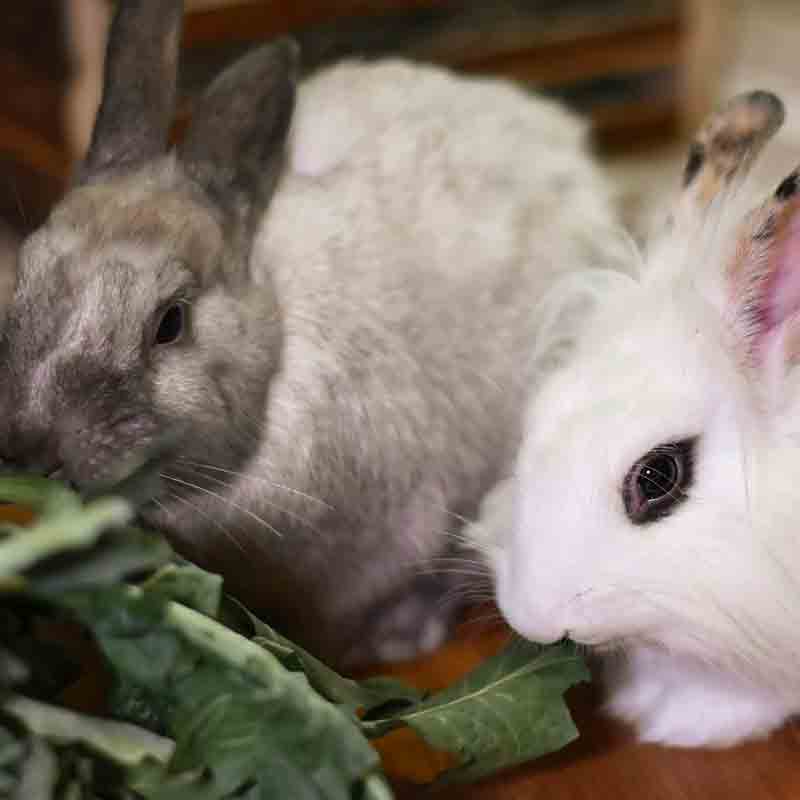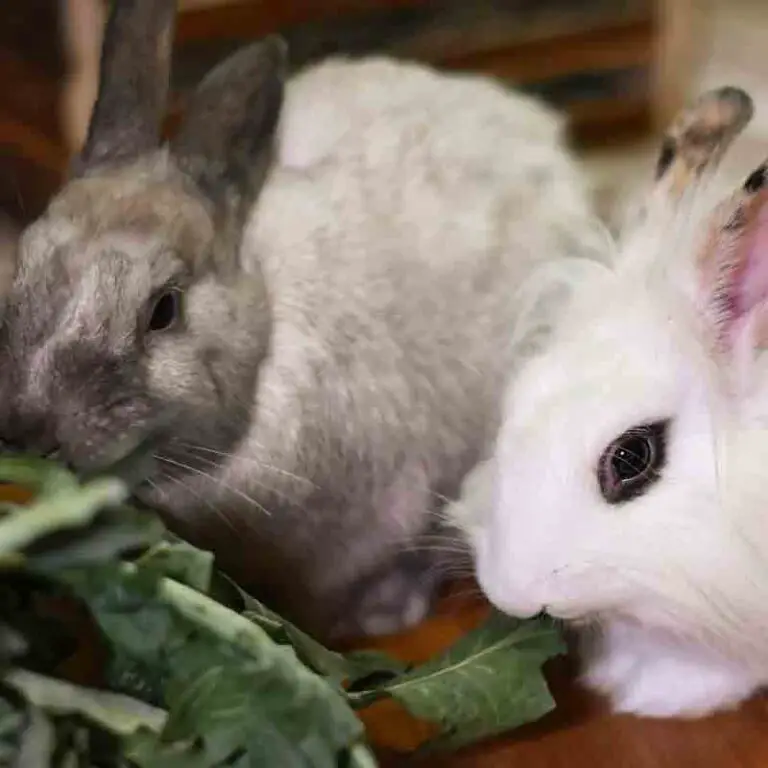When to separate male and female rabbits is a common question that many new rabbit owners have in mind. As we all know that rabbits are social animals and should be kept in pairs, but what happens when you have one male and one female rabbit? When is it time to separate them? And how do you go about it?
This article will cover everything you need to know about separating male and female rabbits.

When To Separate Male And Female Rabbits?
There is no one definitive answer to this question as it depends on the specific situation. Rabbits of both genders (male and female) will usually get along and do not need to be separated.
However, there are some guidelines that can help you decide when the time is right to separate male and female rabbits. But there are times when it may be necessary:
1. Breeding
If your intention is to breed one or more rabbits, then separation for longer periods is necessary, during the breeding season of the animals. This period can last from a couple of days up to several weeks depending on parity, litter size, and breed.
For parity, check the number of litters a rabbit has had previously – if it’s the first time having babies it could take her longer than usual to wean them off. Also, check how many kits she gave birth to so you can decide how long they must stay with mom before being separated.
2. Behavior
A rabbit in estrus (heat) can be very moody, irritable, and even aggressive towards other household companions as well as humans.
Your pet may also exhibit these behaviors during non-breeding months if you have not been able to separate a male from a female for a long period of time. Females will often assume the mating stance when they are in heat, so this behavior is a good indicator that it’s time to separate your pets for a while.
3. Spaying/Neutering
When rabbits around 4 months old reach physical maturity, they may need to be spayed or neutered according to their gender – although some small breeds have delayed maturity and benefit from one animal per cage until after 6 months of age.
4. Health
If one or both rabbits are ill, it’s best to keep them in separate cages for better observation and treatment. If their temperaments are incompatible when healthy, there is a high risk that they will fight when sick.
5. First Time Bonding
Unsterilized rabbits may not get along once spayed/neutered because of changes in personality after sterilization.
Before you place your pets in the same cage together, make sure they have had ample time to adjust with each other in neutral territory first, away from their home enclosure if possible, then later reintroduce them into the familiar territory gradually at least 15 minutes at a time so they do not fight.
6. Litter Training
If you use litter training to train your rabbits, it’s best to place each animal in an individual cage so that they can be trained properly with no distractions.
Roles are also reassigned after the spaying/neutering process, so re-training may be necessary which is easiest when there are no other pets around to distract them from their new duties.
7. Restraining a rabbit during a veterinary visit
It has been noted by many veterinarians that having another animal nearby makes it easier and safer for them to perform a physical examination or even administer shots – especially if the other pet is calm and friendly towards humans already, as this transfers well to the sicker pet who can benefit from its presence.
8. Introducing a New Pet
If you are introducing a new pet into the home, it is best to place them in a separate room until you can determine whether or not they will get along. This is especially important if you have an existing rabbit in the home, as it may be stressed by the newcomer’s presence and could become ill.
9. Quarantine Period
If your rabbit has been exposed to another sick rabbit, it is important to place them in a separate cage and keep them isolated for at least 3 weeks to see if they develop any symptoms. In some cases, 6 weeks may be necessary to ensure your rabbit is healthy again.
As we now know When To Separate Male And Female Rabbits, let’s clear the other doubts related to rabbits living together.

How long do you leave a male and female rabbit together?
The best way to increase your rabbit’s litter size is by getting them bred. The ideal time for this process can be determined depending on how many hours you want between pregnancies, but it usually ranges from 2-3 periods of inactivity during which no breeding takes place (a ” lounging” period).
You should always have one female with another male whenever possible because they will then breed more often than if there was just an individual animal—and greater success means smaller litters or even young!
Can two Female Rabbits live Together?
Yes, many experts say that two female rabbits can live together harmoniously, providing they have been spayed and neutered. Introducing two unaltered female rabbits can sometimes lead to territorial behavior and fighting, so it’s best to wait until after they have been spayed/neutered to give them the best chance for successful cohabitation.
If you do introduce two females before sterilization, be prepared for possible aggression and keep a close eye on them to separate them if necessary.

Can Two Male Rabbits Live Together?
Yes, Male rabbits can also live together, but it is important to remember that they will need to be neutered in order to prevent testosterone-fueled fighting.
Introducing two unaltered males is not recommended; they are more likely to fight than females and can severely injure each other. If you do wish to introduce two males together, make sure they have been neutered first or place them into different cages if their bonding process is slow.
When Can Rabbits Live Together Again After Separation?
When can rabbits live together again after separation depends upon a few factors, We discussed the reasons for our topic When To Separate Male And Female Rabbits.
This varies depending on the length of time apart. Often, even after a relatively short period of time (a few days), it may take some rabbits longer than others to get along again so be prepared for this possibility.
Generally speaking, once the female has had her heat cycle she will be ready to mate again within 24 hours following ovulation so keep an eye out for any amorous advances towards the male which indicate it is time to separate again.
How do you introduce two rabbits together?
The first thing to remember when introducing two rabbits is that they need to be neutered before you start trying to put them together. After this initial step, all you need to do is give the rabbits an opportunity to become familiar with each other’s scent.
A large open space – like a very large dog- or bunny-proofed room – works best here for both animals’ safety and because it allows them to explore at their own pace until they are more comfortable around each other.
Remember that rabbits have different personalities just as dogs and cats do, so some may take longer than others to adjust fully. Keep an eye on any scuffles that might break out between the two of them but if everything seems peaceful then you can let them stay together overnight.
Can two different types of rabbits live together?
Yes, two different breeds of rabbits can live together as long as both of them are neutered.
Remember that rabbits of different breeds can look very different from each other, so if you are introducing a new rabbit to your home, be sure to spend some time getting to know its personality and whether it would be compatible with the other rabbits in your house.
How Long Can We Keep A Male And Female Rabbit Together?
The male must be separated at the first sign of any aggression or dominance on his part if you are keeping them together for more than a few days. This will prevent injury to either rabbit and may even save both rabbits’ lives since fights can be very serious with these naturally territorial animals, despite their generally docile nature.
When your female’s heat cycle approaches – an event that will happen several times each year – you’ll notice she becomes extremely affectionate towards her cage-mate, grooming him extensively and wanting to spend all of her time in close contact with him. When this happens, it’s definitely time to separate the two rabbits again.
The male will start to mount the female, and while this may seem cute to us humans it’s actually a very aggressive act on his part and can lead to serious injuries.
Separating your rabbits at other times during the year is not absolutely necessary, but it is always a good idea to be aware of their natural behaviors and when fights are more likely to occur. With a little bit of planning, you can successfully keep a male and female rabbit together without any bloodshed.
Final Words
If you are serious about breeding rabbits, then separation for long periods of time is necessary. Keeping them apart for four weeks after they have been introduced will help the female rabbit’s hormones regulate and give her a chance to get ready for pregnancy.
Keep in mind that if your intention was simply to introduce two bunnies or provide companionship, then this may not be necessary. The bottom line is that there are many factors involved when it comes to breeding rabbits successfully but following these guidelines can certainly help improve your odds!
Similar Posts:




